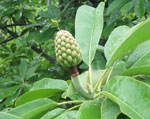|
PAST SUCCESSES
Magnolias, China
Project Dates: June 2005 - January 2007 (see also Chinese Magnolias in Current Projects)
China is host to approximately 40% of the 245 known species of magnolia. At a Global Trees Campaign workshop in China in June 2004, organised as part of the data-gathering for the Red List of Magnoliaceae, 14 Chinese Magnolia species were identified as threatened with extinction in the wild. Threats to wild magnolias include habitat loss and fragmentation, and over-exploitation for medicinal or ornamental use. Some species have been reduced to perilously small numbers, such as the Critically Endangered Magnolia sinica, which now numbers just 10 trees in the wild. Five species were prioritised as being most urgently in need of conservation action: Magnolia sinica, Magnolia grandis, Magnolia sargentiana, Magnolia phanerophlebia, Magnolia coriacea.
In partnership with the Kunming Institute of Botany, with funding from the Flagship Species Fund, conservation action for the five top priority species was initiated in 2005. The project aimed to fill some of the information gaps about these species that were identified at the Kunming workshop though field visits and surveys, and to locate priority areas and potential opportunities for their conservation.
Outcomes
The project gathered a wealth of information on these five species in the wild, identified further information needs and developed opportunities for conservation action. Specific successes included:
• Assessment of the population and distribution of the five target species to provide a basis for future conservation action. Five field surveys were conducted to identify areas of suitable habitat.
• The discovery that Magnolia sargentiana is more numerous than previously thought (30,000-40,000 individuals), resulting in a down-grading of its threat category from Endangered to Vulnerable.
• Identification of the main threats to the target species to allow effective conservation planning. Habitat loss and damage was identified as being a threat to Magnolia phanerophlebia and Magnolia sargentiana in particular. Low fruiting rates in all species were also discovered during the surveys. Collection of the bark of Magnolia sargentiana for medicinal use was also suggested to be a threat.
• Identification of future needs and opportunities for conservation of the target species. In particular the development of cultivation techniques and the planting of seedlings from private nurseries were identified as being essential. Raising awareness in local communities was also recommended to help prevent over-harvesting of magnolias for medicinal use and the clearing of land for agriculture and other uses.
• The location of 5,000-6,000 seedlings of Magnolia sinica in local nurseries – a significant discovery as the tree is reduced to just 10 individuals in the wild.
Following this initial data-gathering project, further action is currently underway for Magnolia sinica, Magnolia coriacea and Magnolia phanerophlebia – see Chinese Magnolias.
Article from FFI's magazine, Fauna & Flora, published August 2005:
Mitigating Threats To Chinese Magnolias In June 2004 FFI’s Global Trees Campaign and the IUCN SSC Global Trees Specialist Group hosted a workshop that looked at the threats facing Chinese magnolias and what could be done to conserve them. Held in Kunming, Yunnan province, this workshop brought together Magnoliaceae experts from the Yunnan Academy of Forestry Sciences, Kunming Institute of Botany and South China Botanic Garden, amongst others. An initial assessment using the IUCN Red List criteria helped to establish the threat status, after which the participants discussed priority species, their research and current and potential conservation efforts. Of the 42 species assessed, 14 were identified as priorities, threatened due to widespread habitat loss from agriculture and woodcutting, poor regeneration, horticultural demand and the medicinal plant trade. In many cases, adequate information to make an accurate assessment is simply unavailable. The species assessed include: Manglietia sinica, a stunning tree up to 40 metres tall, with heavily scented cream and red flowers, thought to number only six or seven individuals in the wild. It is threatened by the loss of montane evergreen broadleaved forests and by specific felling for its straight, fine grained and durable timber, although it is now protected under Chinese State Protection Category I. Magnolia phanerophlebia, known from only one area, thought to include fewer than 250 individuals, and threatened by habitat loss. With beautifully scented, pale apricot coloured flowers and large dark green leaves, this is a potentially important species for horticulture. Working with the magnolia workshop participants, as well as FFI staff in China and Vietnam, the Global Trees Campaign has initiated a project that aims to bring together botanists and conservationists to study and conserve threatened magnolias in situ near the China-Vietnam border, and to promote their conservation more widely through horticulture. Initially supported by the Flagship Species Fund, this work includes: surveys and assessment of the remaining habitat and the threats to it; a review of collection and use in the medicinal plant and horticultural trades; investigation of techniques for non-destructive collection and propagation; and identification of important sites for conservation. With support from the Royal Horticultural Society, this project also aims to promote magnolia conservation by working with UK horticulturalists who may be unaware of how threatened these spectacular plants are in the wild. More funding is now being sought to develop this project and turn the survey findings into in situ conservation by establishing reserves and methods for sustainable harvest and propagation of species of economic importance.
Back to Past Successes
|




|







